Corporate Finance Report: Analyzing Kellogg's Dividend Policy (MBA)
VerifiedAdded on 2022/12/23
|9
|2465
|27
Report
AI Summary
This report, prepared for the treasury department of Kellogg's, a multinational consumer packaged goods company, analyzes the company's dividend policy. It begins by explaining the importance of dividend decisions, emphasizing their role in providing information to investors, encouraging management discipline, increasing shareholder engagement, and promoting the company's reputation. The report then reviews Kellogg's dividend policy and performance over the last five years, examining metrics such as dividend per share and payout ratio. Furthermore, it discusses major dividend policy theories, including Walter's model, Gordon's model, and the Modigliani and Miller theory, outlining their assumptions and criticisms. Finally, the report recommends a future dividend policy for Kellogg's, suggesting a regular dividend policy to retain investors and ensure financial stability. The analysis is based on the provided data and financial principles, aiming to maximize shareholder value and guide future dividend strategies.
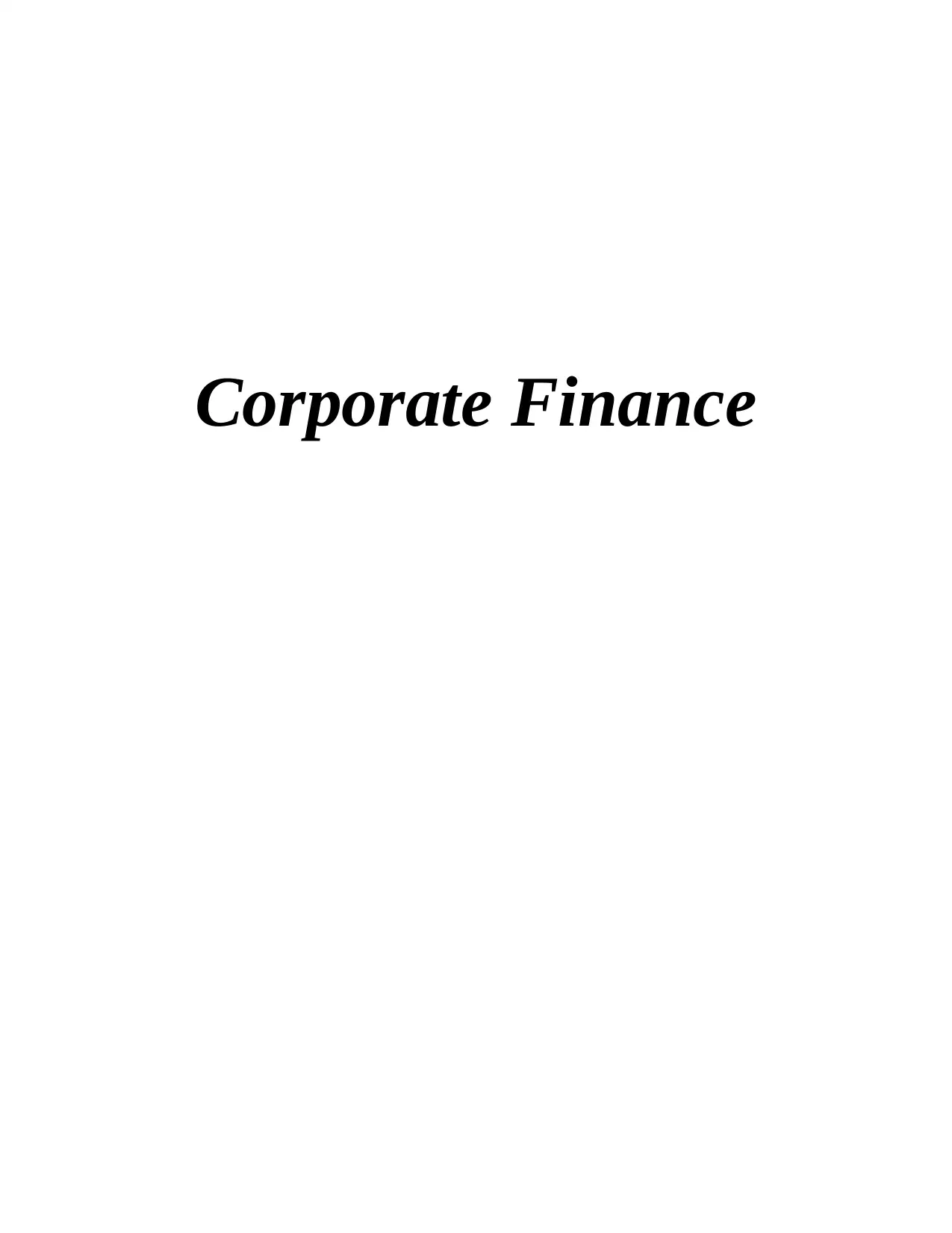
Corporate Finance
Paraphrase This Document
Need a fresh take? Get an instant paraphrase of this document with our AI Paraphraser
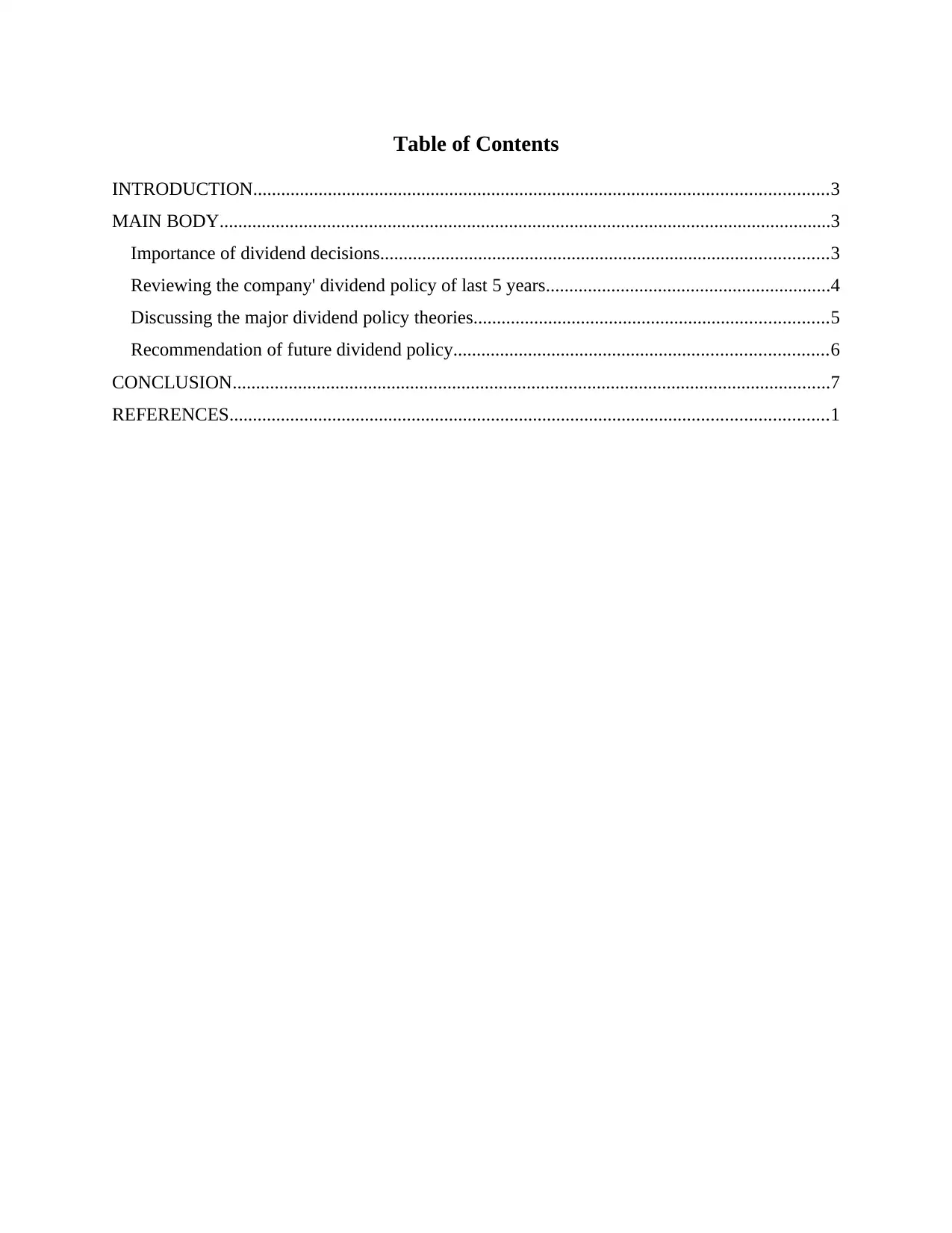
Table of Contents
INTRODUCTION...........................................................................................................................3
MAIN BODY...................................................................................................................................3
Importance of dividend decisions................................................................................................3
Reviewing the company' dividend policy of last 5 years.............................................................4
Discussing the major dividend policy theories............................................................................5
Recommendation of future dividend policy................................................................................6
CONCLUSION................................................................................................................................7
REFERENCES................................................................................................................................1
INTRODUCTION...........................................................................................................................3
MAIN BODY...................................................................................................................................3
Importance of dividend decisions................................................................................................3
Reviewing the company' dividend policy of last 5 years.............................................................4
Discussing the major dividend policy theories............................................................................5
Recommendation of future dividend policy................................................................................6
CONCLUSION................................................................................................................................7
REFERENCES................................................................................................................................1
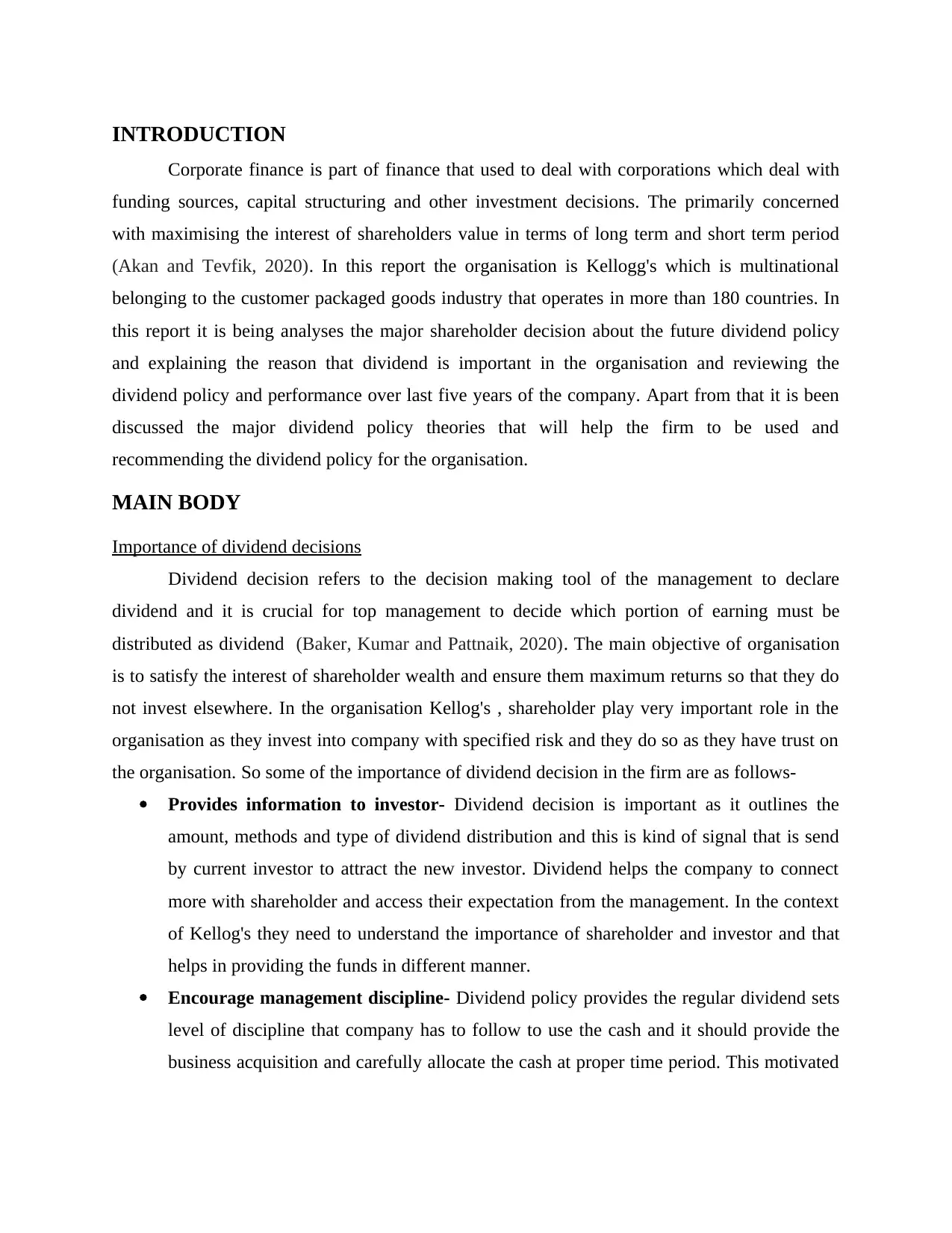
INTRODUCTION
Corporate finance is part of finance that used to deal with corporations which deal with
funding sources, capital structuring and other investment decisions. The primarily concerned
with maximising the interest of shareholders value in terms of long term and short term period
(Akan and Tevfik, 2020). In this report the organisation is Kellogg's which is multinational
belonging to the customer packaged goods industry that operates in more than 180 countries. In
this report it is being analyses the major shareholder decision about the future dividend policy
and explaining the reason that dividend is important in the organisation and reviewing the
dividend policy and performance over last five years of the company. Apart from that it is been
discussed the major dividend policy theories that will help the firm to be used and
recommending the dividend policy for the organisation.
MAIN BODY
Importance of dividend decisions
Dividend decision refers to the decision making tool of the management to declare
dividend and it is crucial for top management to decide which portion of earning must be
distributed as dividend (Baker, Kumar and Pattnaik, 2020). The main objective of organisation
is to satisfy the interest of shareholder wealth and ensure them maximum returns so that they do
not invest elsewhere. In the organisation Kellog's , shareholder play very important role in the
organisation as they invest into company with specified risk and they do so as they have trust on
the organisation. So some of the importance of dividend decision in the firm are as follows-
Provides information to investor- Dividend decision is important as it outlines the
amount, methods and type of dividend distribution and this is kind of signal that is send
by current investor to attract the new investor. Dividend helps the company to connect
more with shareholder and access their expectation from the management. In the context
of Kellog's they need to understand the importance of shareholder and investor and that
helps in providing the funds in different manner.
Encourage management discipline- Dividend policy provides the regular dividend sets
level of discipline that company has to follow to use the cash and it should provide the
business acquisition and carefully allocate the cash at proper time period. This motivated
Corporate finance is part of finance that used to deal with corporations which deal with
funding sources, capital structuring and other investment decisions. The primarily concerned
with maximising the interest of shareholders value in terms of long term and short term period
(Akan and Tevfik, 2020). In this report the organisation is Kellogg's which is multinational
belonging to the customer packaged goods industry that operates in more than 180 countries. In
this report it is being analyses the major shareholder decision about the future dividend policy
and explaining the reason that dividend is important in the organisation and reviewing the
dividend policy and performance over last five years of the company. Apart from that it is been
discussed the major dividend policy theories that will help the firm to be used and
recommending the dividend policy for the organisation.
MAIN BODY
Importance of dividend decisions
Dividend decision refers to the decision making tool of the management to declare
dividend and it is crucial for top management to decide which portion of earning must be
distributed as dividend (Baker, Kumar and Pattnaik, 2020). The main objective of organisation
is to satisfy the interest of shareholder wealth and ensure them maximum returns so that they do
not invest elsewhere. In the organisation Kellog's , shareholder play very important role in the
organisation as they invest into company with specified risk and they do so as they have trust on
the organisation. So some of the importance of dividend decision in the firm are as follows-
Provides information to investor- Dividend decision is important as it outlines the
amount, methods and type of dividend distribution and this is kind of signal that is send
by current investor to attract the new investor. Dividend helps the company to connect
more with shareholder and access their expectation from the management. In the context
of Kellog's they need to understand the importance of shareholder and investor and that
helps in providing the funds in different manner.
Encourage management discipline- Dividend policy provides the regular dividend sets
level of discipline that company has to follow to use the cash and it should provide the
business acquisition and carefully allocate the cash at proper time period. This motivated
⊘ This is a preview!⊘
Do you want full access?
Subscribe today to unlock all pages.

Trusted by 1+ million students worldwide
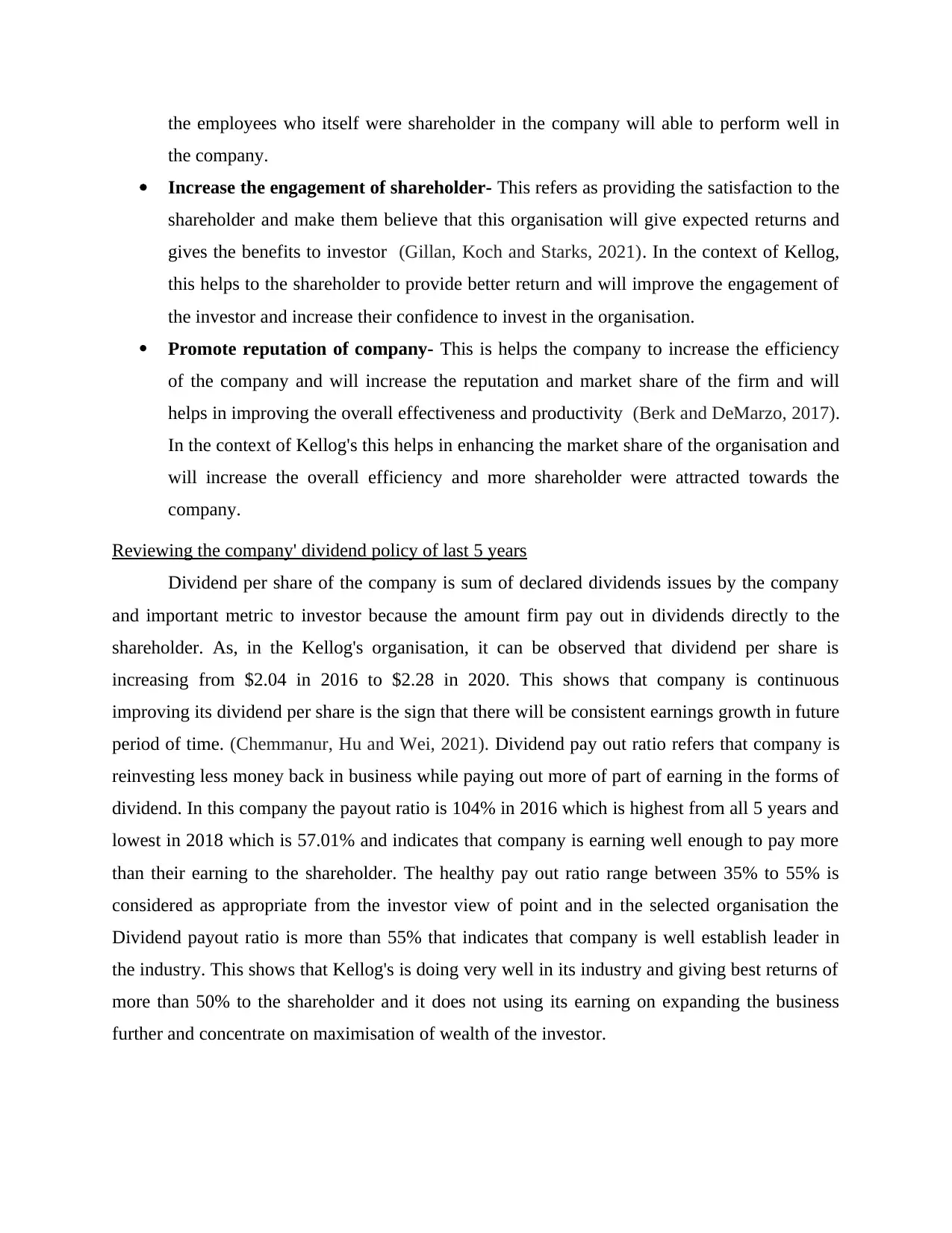
the employees who itself were shareholder in the company will able to perform well in
the company.
Increase the engagement of shareholder- This refers as providing the satisfaction to the
shareholder and make them believe that this organisation will give expected returns and
gives the benefits to investor (Gillan, Koch and Starks, 2021). In the context of Kellog,
this helps to the shareholder to provide better return and will improve the engagement of
the investor and increase their confidence to invest in the organisation.
Promote reputation of company- This is helps the company to increase the efficiency
of the company and will increase the reputation and market share of the firm and will
helps in improving the overall effectiveness and productivity (Berk and DeMarzo, 2017).
In the context of Kellog's this helps in enhancing the market share of the organisation and
will increase the overall efficiency and more shareholder were attracted towards the
company.
Reviewing the company' dividend policy of last 5 years
Dividend per share of the company is sum of declared dividends issues by the company
and important metric to investor because the amount firm pay out in dividends directly to the
shareholder. As, in the Kellog's organisation, it can be observed that dividend per share is
increasing from $2.04 in 2016 to $2.28 in 2020. This shows that company is continuous
improving its dividend per share is the sign that there will be consistent earnings growth in future
period of time. (Chemmanur, Hu and Wei, 2021). Dividend pay out ratio refers that company is
reinvesting less money back in business while paying out more of part of earning in the forms of
dividend. In this company the payout ratio is 104% in 2016 which is highest from all 5 years and
lowest in 2018 which is 57.01% and indicates that company is earning well enough to pay more
than their earning to the shareholder. The healthy pay out ratio range between 35% to 55% is
considered as appropriate from the investor view of point and in the selected organisation the
Dividend payout ratio is more than 55% that indicates that company is well establish leader in
the industry. This shows that Kellog's is doing very well in its industry and giving best returns of
more than 50% to the shareholder and it does not using its earning on expanding the business
further and concentrate on maximisation of wealth of the investor.
the company.
Increase the engagement of shareholder- This refers as providing the satisfaction to the
shareholder and make them believe that this organisation will give expected returns and
gives the benefits to investor (Gillan, Koch and Starks, 2021). In the context of Kellog,
this helps to the shareholder to provide better return and will improve the engagement of
the investor and increase their confidence to invest in the organisation.
Promote reputation of company- This is helps the company to increase the efficiency
of the company and will increase the reputation and market share of the firm and will
helps in improving the overall effectiveness and productivity (Berk and DeMarzo, 2017).
In the context of Kellog's this helps in enhancing the market share of the organisation and
will increase the overall efficiency and more shareholder were attracted towards the
company.
Reviewing the company' dividend policy of last 5 years
Dividend per share of the company is sum of declared dividends issues by the company
and important metric to investor because the amount firm pay out in dividends directly to the
shareholder. As, in the Kellog's organisation, it can be observed that dividend per share is
increasing from $2.04 in 2016 to $2.28 in 2020. This shows that company is continuous
improving its dividend per share is the sign that there will be consistent earnings growth in future
period of time. (Chemmanur, Hu and Wei, 2021). Dividend pay out ratio refers that company is
reinvesting less money back in business while paying out more of part of earning in the forms of
dividend. In this company the payout ratio is 104% in 2016 which is highest from all 5 years and
lowest in 2018 which is 57.01% and indicates that company is earning well enough to pay more
than their earning to the shareholder. The healthy pay out ratio range between 35% to 55% is
considered as appropriate from the investor view of point and in the selected organisation the
Dividend payout ratio is more than 55% that indicates that company is well establish leader in
the industry. This shows that Kellog's is doing very well in its industry and giving best returns of
more than 50% to the shareholder and it does not using its earning on expanding the business
further and concentrate on maximisation of wealth of the investor.
Paraphrase This Document
Need a fresh take? Get an instant paraphrase of this document with our AI Paraphraser
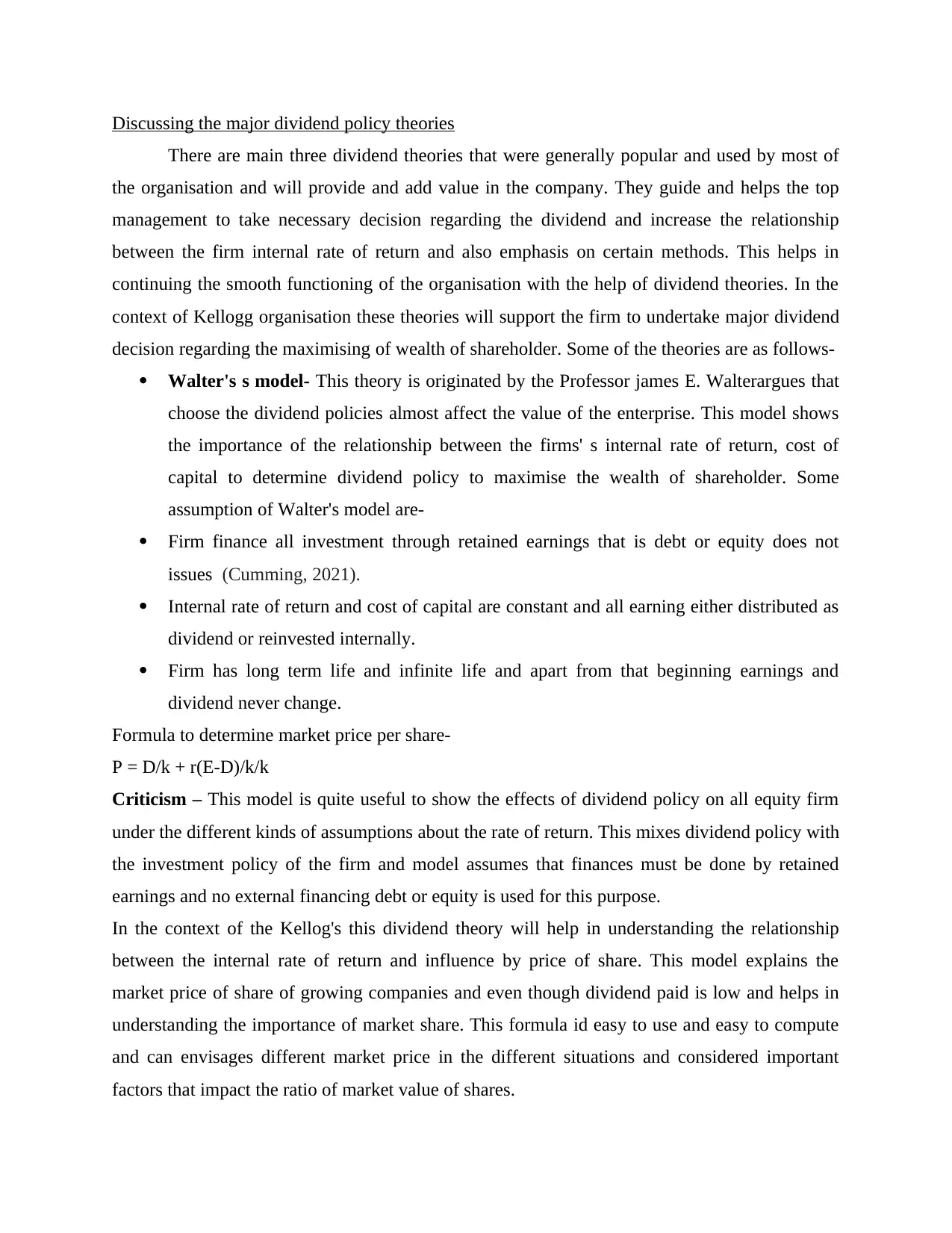
Discussing the major dividend policy theories
There are main three dividend theories that were generally popular and used by most of
the organisation and will provide and add value in the company. They guide and helps the top
management to take necessary decision regarding the dividend and increase the relationship
between the firm internal rate of return and also emphasis on certain methods. This helps in
continuing the smooth functioning of the organisation with the help of dividend theories. In the
context of Kellogg organisation these theories will support the firm to undertake major dividend
decision regarding the maximising of wealth of shareholder. Some of the theories are as follows-
Walter's s model- This theory is originated by the Professor james E. Walterargues that
choose the dividend policies almost affect the value of the enterprise. This model shows
the importance of the relationship between the firms' s internal rate of return, cost of
capital to determine dividend policy to maximise the wealth of shareholder. Some
assumption of Walter's model are-
Firm finance all investment through retained earnings that is debt or equity does not
issues (Cumming, 2021).
Internal rate of return and cost of capital are constant and all earning either distributed as
dividend or reinvested internally.
Firm has long term life and infinite life and apart from that beginning earnings and
dividend never change.
Formula to determine market price per share-
P = D/k + r(E-D)/k/k
Criticism – This model is quite useful to show the effects of dividend policy on all equity firm
under the different kinds of assumptions about the rate of return. This mixes dividend policy with
the investment policy of the firm and model assumes that finances must be done by retained
earnings and no external financing debt or equity is used for this purpose.
In the context of the Kellog's this dividend theory will help in understanding the relationship
between the internal rate of return and influence by price of share. This model explains the
market price of share of growing companies and even though dividend paid is low and helps in
understanding the importance of market share. This formula id easy to use and easy to compute
and can envisages different market price in the different situations and considered important
factors that impact the ratio of market value of shares.
There are main three dividend theories that were generally popular and used by most of
the organisation and will provide and add value in the company. They guide and helps the top
management to take necessary decision regarding the dividend and increase the relationship
between the firm internal rate of return and also emphasis on certain methods. This helps in
continuing the smooth functioning of the organisation with the help of dividend theories. In the
context of Kellogg organisation these theories will support the firm to undertake major dividend
decision regarding the maximising of wealth of shareholder. Some of the theories are as follows-
Walter's s model- This theory is originated by the Professor james E. Walterargues that
choose the dividend policies almost affect the value of the enterprise. This model shows
the importance of the relationship between the firms' s internal rate of return, cost of
capital to determine dividend policy to maximise the wealth of shareholder. Some
assumption of Walter's model are-
Firm finance all investment through retained earnings that is debt or equity does not
issues (Cumming, 2021).
Internal rate of return and cost of capital are constant and all earning either distributed as
dividend or reinvested internally.
Firm has long term life and infinite life and apart from that beginning earnings and
dividend never change.
Formula to determine market price per share-
P = D/k + r(E-D)/k/k
Criticism – This model is quite useful to show the effects of dividend policy on all equity firm
under the different kinds of assumptions about the rate of return. This mixes dividend policy with
the investment policy of the firm and model assumes that finances must be done by retained
earnings and no external financing debt or equity is used for this purpose.
In the context of the Kellog's this dividend theory will help in understanding the relationship
between the internal rate of return and influence by price of share. This model explains the
market price of share of growing companies and even though dividend paid is low and helps in
understanding the importance of market share. This formula id easy to use and easy to compute
and can envisages different market price in the different situations and considered important
factors that impact the ratio of market value of shares.
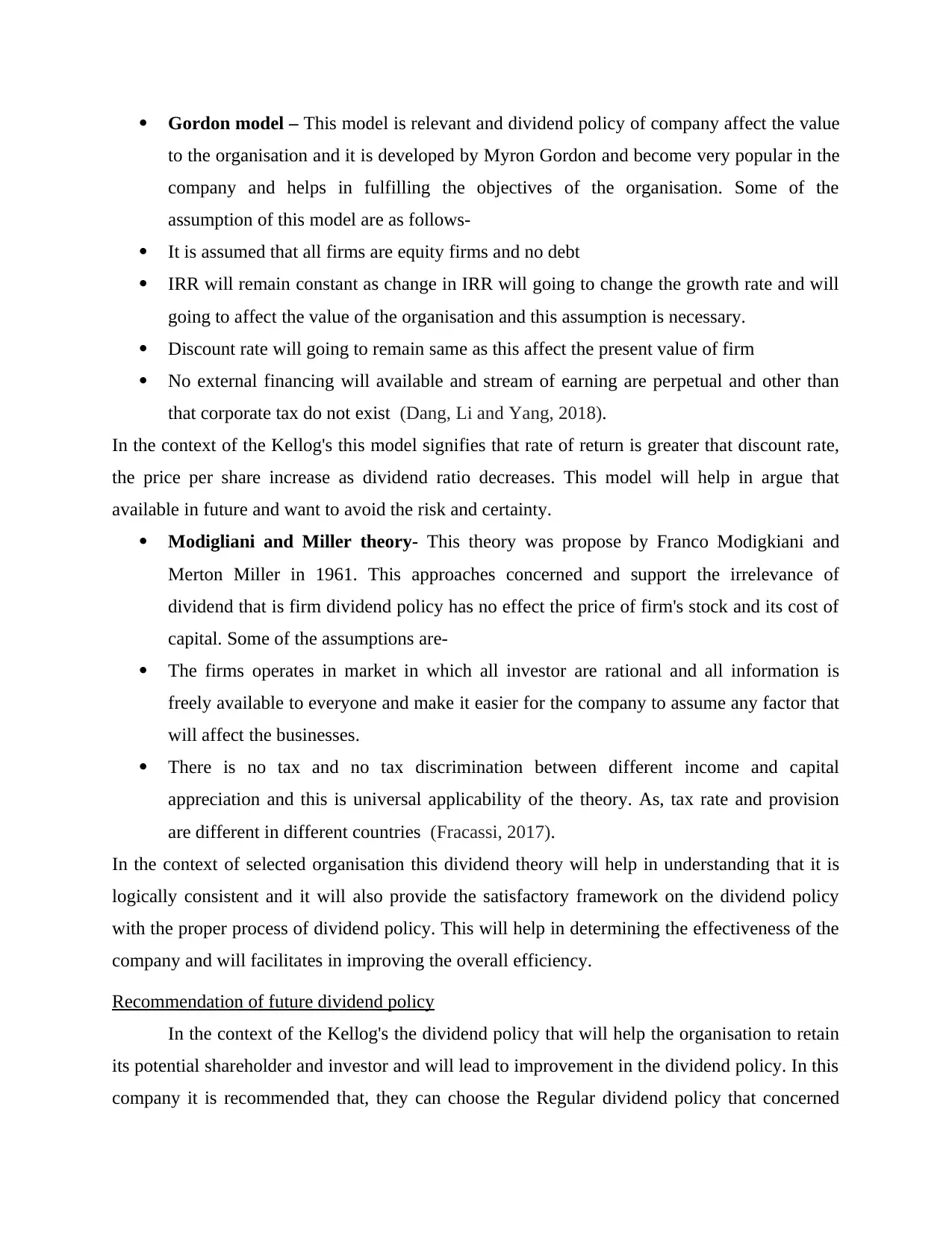
Gordon model – This model is relevant and dividend policy of company affect the value
to the organisation and it is developed by Myron Gordon and become very popular in the
company and helps in fulfilling the objectives of the organisation. Some of the
assumption of this model are as follows-
It is assumed that all firms are equity firms and no debt
IRR will remain constant as change in IRR will going to change the growth rate and will
going to affect the value of the organisation and this assumption is necessary.
Discount rate will going to remain same as this affect the present value of firm
No external financing will available and stream of earning are perpetual and other than
that corporate tax do not exist (Dang, Li and Yang, 2018).
In the context of the Kellog's this model signifies that rate of return is greater that discount rate,
the price per share increase as dividend ratio decreases. This model will help in argue that
available in future and want to avoid the risk and certainty.
Modigliani and Miller theory- This theory was propose by Franco Modigkiani and
Merton Miller in 1961. This approaches concerned and support the irrelevance of
dividend that is firm dividend policy has no effect the price of firm's stock and its cost of
capital. Some of the assumptions are-
The firms operates in market in which all investor are rational and all information is
freely available to everyone and make it easier for the company to assume any factor that
will affect the businesses.
There is no tax and no tax discrimination between different income and capital
appreciation and this is universal applicability of the theory. As, tax rate and provision
are different in different countries (Fracassi, 2017).
In the context of selected organisation this dividend theory will help in understanding that it is
logically consistent and it will also provide the satisfactory framework on the dividend policy
with the proper process of dividend policy. This will help in determining the effectiveness of the
company and will facilitates in improving the overall efficiency.
Recommendation of future dividend policy
In the context of the Kellog's the dividend policy that will help the organisation to retain
its potential shareholder and investor and will lead to improvement in the dividend policy. In this
company it is recommended that, they can choose the Regular dividend policy that concerned
to the organisation and it is developed by Myron Gordon and become very popular in the
company and helps in fulfilling the objectives of the organisation. Some of the
assumption of this model are as follows-
It is assumed that all firms are equity firms and no debt
IRR will remain constant as change in IRR will going to change the growth rate and will
going to affect the value of the organisation and this assumption is necessary.
Discount rate will going to remain same as this affect the present value of firm
No external financing will available and stream of earning are perpetual and other than
that corporate tax do not exist (Dang, Li and Yang, 2018).
In the context of the Kellog's this model signifies that rate of return is greater that discount rate,
the price per share increase as dividend ratio decreases. This model will help in argue that
available in future and want to avoid the risk and certainty.
Modigliani and Miller theory- This theory was propose by Franco Modigkiani and
Merton Miller in 1961. This approaches concerned and support the irrelevance of
dividend that is firm dividend policy has no effect the price of firm's stock and its cost of
capital. Some of the assumptions are-
The firms operates in market in which all investor are rational and all information is
freely available to everyone and make it easier for the company to assume any factor that
will affect the businesses.
There is no tax and no tax discrimination between different income and capital
appreciation and this is universal applicability of the theory. As, tax rate and provision
are different in different countries (Fracassi, 2017).
In the context of selected organisation this dividend theory will help in understanding that it is
logically consistent and it will also provide the satisfactory framework on the dividend policy
with the proper process of dividend policy. This will help in determining the effectiveness of the
company and will facilitates in improving the overall efficiency.
Recommendation of future dividend policy
In the context of the Kellog's the dividend policy that will help the organisation to retain
its potential shareholder and investor and will lead to improvement in the dividend policy. In this
company it is recommended that, they can choose the Regular dividend policy that concerned
⊘ This is a preview!⊘
Do you want full access?
Subscribe today to unlock all pages.

Trusted by 1+ million students worldwide
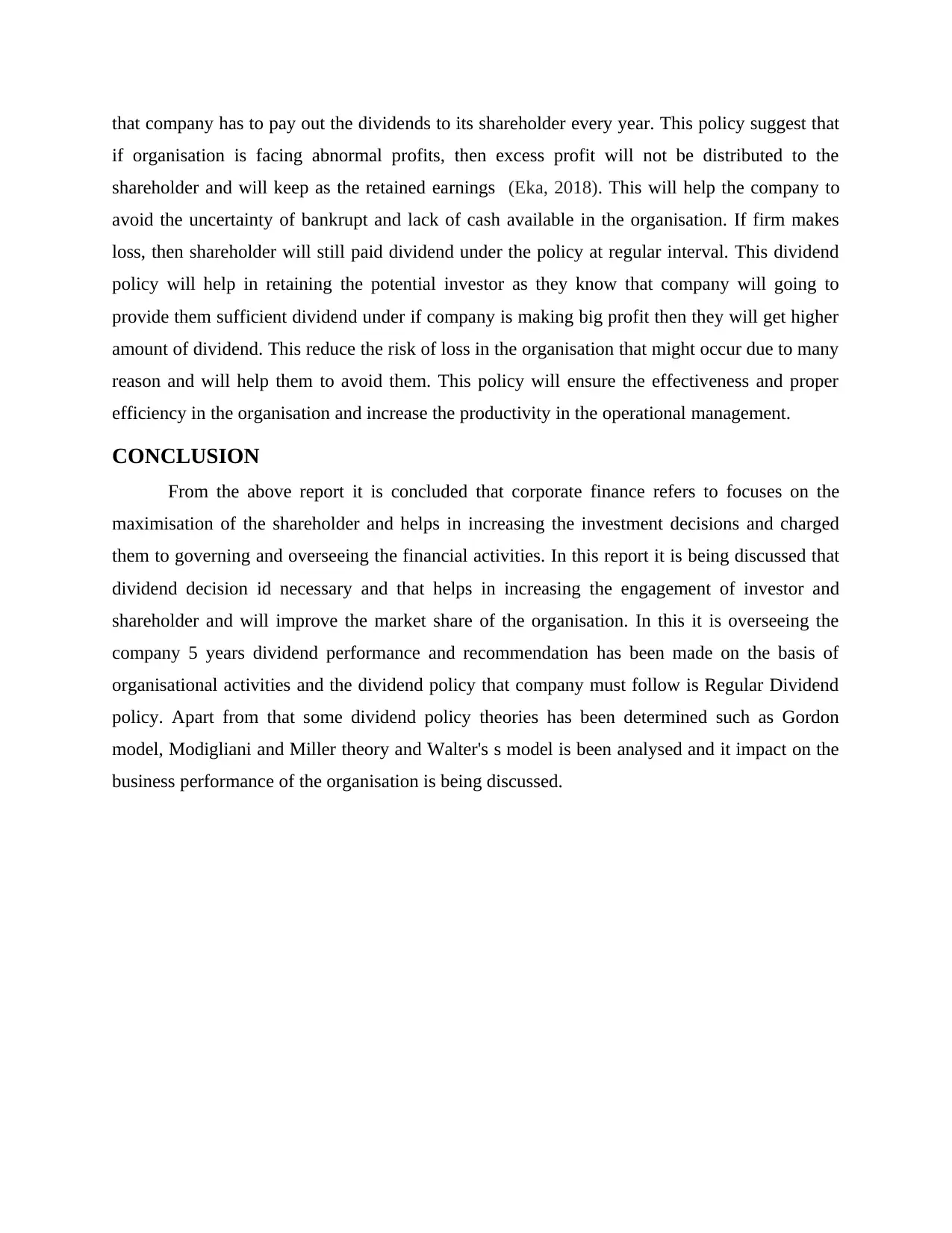
that company has to pay out the dividends to its shareholder every year. This policy suggest that
if organisation is facing abnormal profits, then excess profit will not be distributed to the
shareholder and will keep as the retained earnings (Eka, 2018). This will help the company to
avoid the uncertainty of bankrupt and lack of cash available in the organisation. If firm makes
loss, then shareholder will still paid dividend under the policy at regular interval. This dividend
policy will help in retaining the potential investor as they know that company will going to
provide them sufficient dividend under if company is making big profit then they will get higher
amount of dividend. This reduce the risk of loss in the organisation that might occur due to many
reason and will help them to avoid them. This policy will ensure the effectiveness and proper
efficiency in the organisation and increase the productivity in the operational management.
CONCLUSION
From the above report it is concluded that corporate finance refers to focuses on the
maximisation of the shareholder and helps in increasing the investment decisions and charged
them to governing and overseeing the financial activities. In this report it is being discussed that
dividend decision id necessary and that helps in increasing the engagement of investor and
shareholder and will improve the market share of the organisation. In this it is overseeing the
company 5 years dividend performance and recommendation has been made on the basis of
organisational activities and the dividend policy that company must follow is Regular Dividend
policy. Apart from that some dividend policy theories has been determined such as Gordon
model, Modigliani and Miller theory and Walter's s model is been analysed and it impact on the
business performance of the organisation is being discussed.
if organisation is facing abnormal profits, then excess profit will not be distributed to the
shareholder and will keep as the retained earnings (Eka, 2018). This will help the company to
avoid the uncertainty of bankrupt and lack of cash available in the organisation. If firm makes
loss, then shareholder will still paid dividend under the policy at regular interval. This dividend
policy will help in retaining the potential investor as they know that company will going to
provide them sufficient dividend under if company is making big profit then they will get higher
amount of dividend. This reduce the risk of loss in the organisation that might occur due to many
reason and will help them to avoid them. This policy will ensure the effectiveness and proper
efficiency in the organisation and increase the productivity in the operational management.
CONCLUSION
From the above report it is concluded that corporate finance refers to focuses on the
maximisation of the shareholder and helps in increasing the investment decisions and charged
them to governing and overseeing the financial activities. In this report it is being discussed that
dividend decision id necessary and that helps in increasing the engagement of investor and
shareholder and will improve the market share of the organisation. In this it is overseeing the
company 5 years dividend performance and recommendation has been made on the basis of
organisational activities and the dividend policy that company must follow is Regular Dividend
policy. Apart from that some dividend policy theories has been determined such as Gordon
model, Modigliani and Miller theory and Walter's s model is been analysed and it impact on the
business performance of the organisation is being discussed.
Paraphrase This Document
Need a fresh take? Get an instant paraphrase of this document with our AI Paraphraser
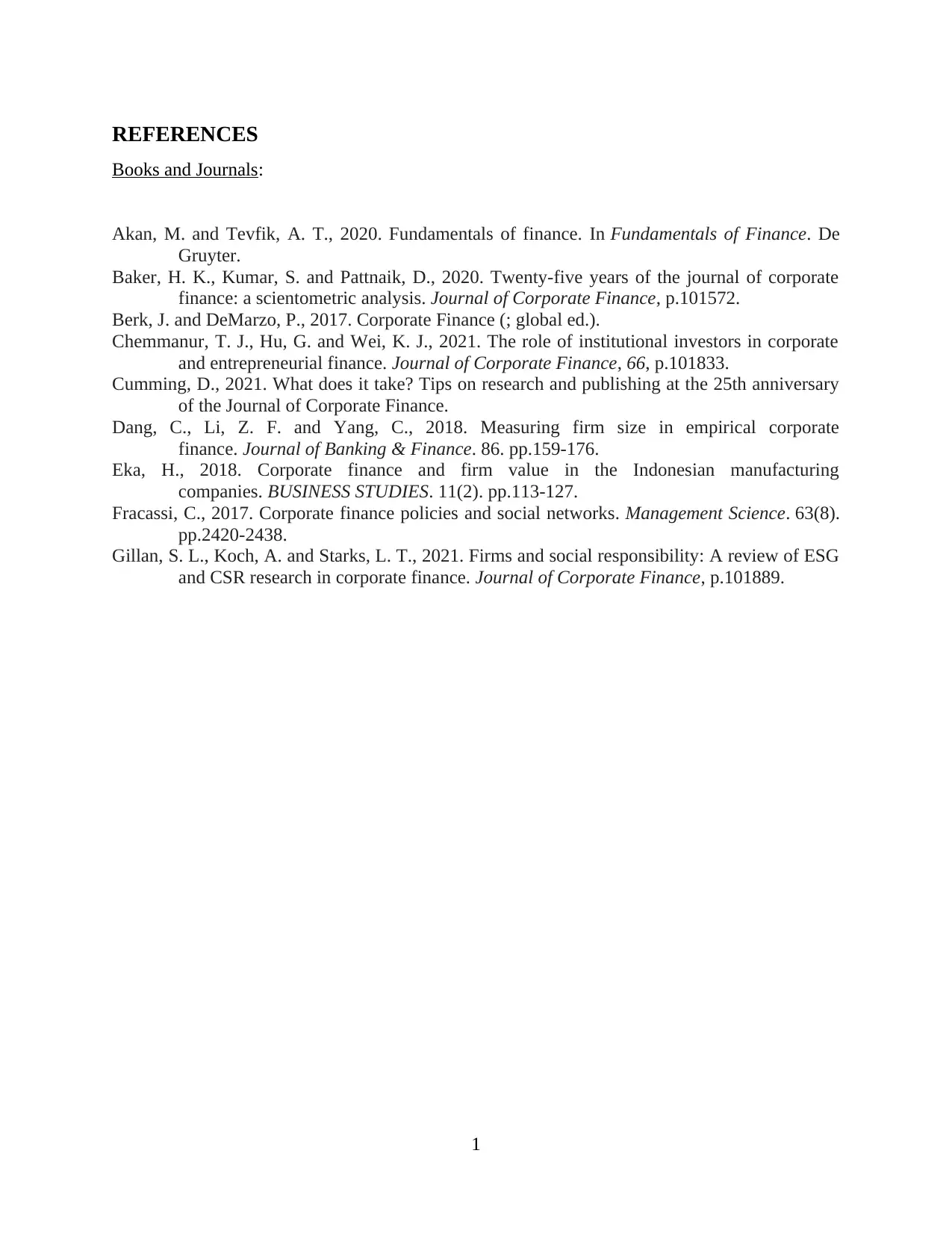
REFERENCES
Books and Journals:
Akan, M. and Tevfik, A. T., 2020. Fundamentals of finance. In Fundamentals of Finance. De
Gruyter.
Baker, H. K., Kumar, S. and Pattnaik, D., 2020. Twenty-five years of the journal of corporate
finance: a scientometric analysis. Journal of Corporate Finance, p.101572.
Berk, J. and DeMarzo, P., 2017. Corporate Finance (; global ed.).
Chemmanur, T. J., Hu, G. and Wei, K. J., 2021. The role of institutional investors in corporate
and entrepreneurial finance. Journal of Corporate Finance, 66, p.101833.
Cumming, D., 2021. What does it take? Tips on research and publishing at the 25th anniversary
of the Journal of Corporate Finance.
Dang, C., Li, Z. F. and Yang, C., 2018. Measuring firm size in empirical corporate
finance. Journal of Banking & Finance. 86. pp.159-176.
Eka, H., 2018. Corporate finance and firm value in the Indonesian manufacturing
companies. BUSINESS STUDIES. 11(2). pp.113-127.
Fracassi, C., 2017. Corporate finance policies and social networks. Management Science. 63(8).
pp.2420-2438.
Gillan, S. L., Koch, A. and Starks, L. T., 2021. Firms and social responsibility: A review of ESG
and CSR research in corporate finance. Journal of Corporate Finance, p.101889.
1
Books and Journals:
Akan, M. and Tevfik, A. T., 2020. Fundamentals of finance. In Fundamentals of Finance. De
Gruyter.
Baker, H. K., Kumar, S. and Pattnaik, D., 2020. Twenty-five years of the journal of corporate
finance: a scientometric analysis. Journal of Corporate Finance, p.101572.
Berk, J. and DeMarzo, P., 2017. Corporate Finance (; global ed.).
Chemmanur, T. J., Hu, G. and Wei, K. J., 2021. The role of institutional investors in corporate
and entrepreneurial finance. Journal of Corporate Finance, 66, p.101833.
Cumming, D., 2021. What does it take? Tips on research and publishing at the 25th anniversary
of the Journal of Corporate Finance.
Dang, C., Li, Z. F. and Yang, C., 2018. Measuring firm size in empirical corporate
finance. Journal of Banking & Finance. 86. pp.159-176.
Eka, H., 2018. Corporate finance and firm value in the Indonesian manufacturing
companies. BUSINESS STUDIES. 11(2). pp.113-127.
Fracassi, C., 2017. Corporate finance policies and social networks. Management Science. 63(8).
pp.2420-2438.
Gillan, S. L., Koch, A. and Starks, L. T., 2021. Firms and social responsibility: A review of ESG
and CSR research in corporate finance. Journal of Corporate Finance, p.101889.
1
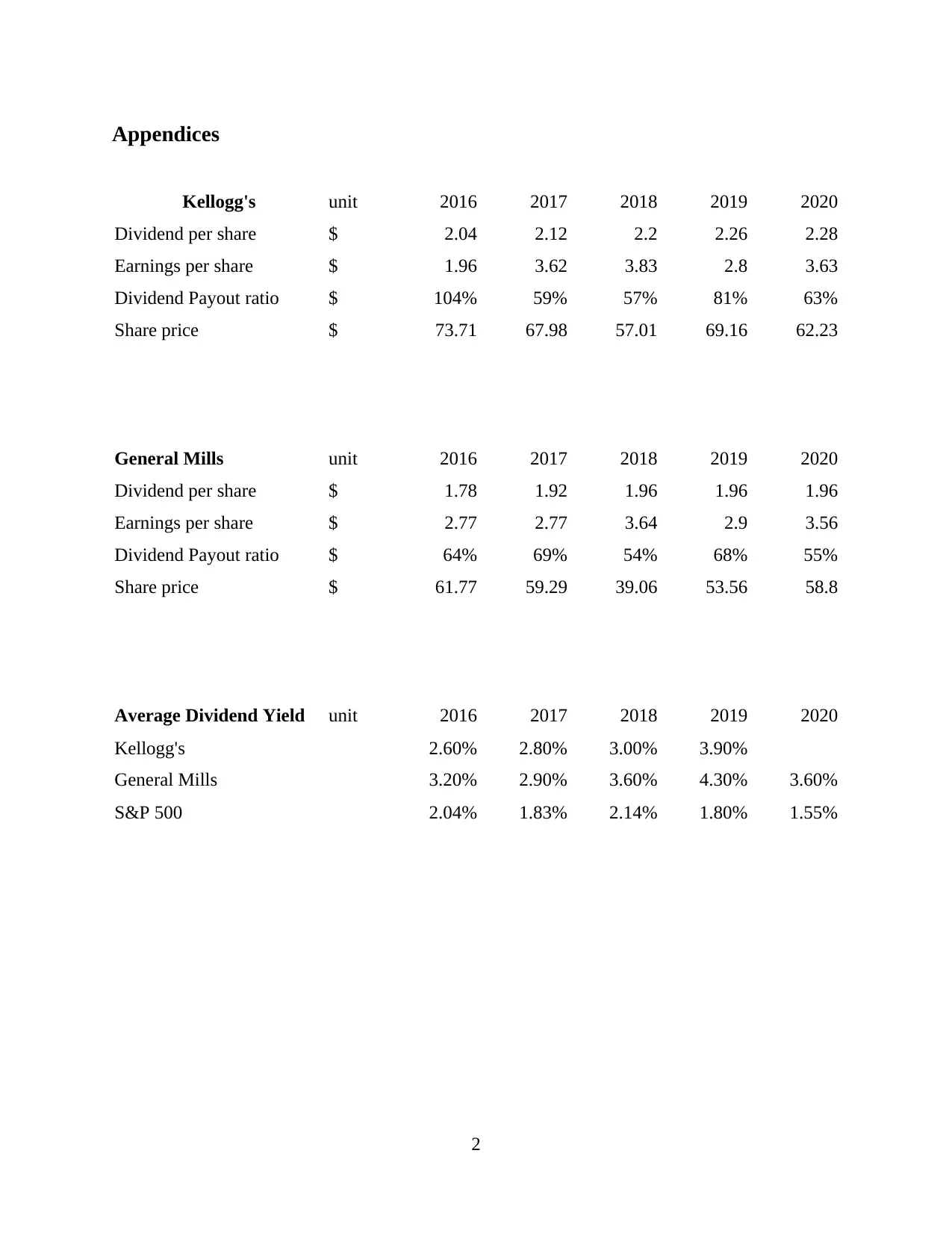
Appendices
Kellogg's unit 2016 2017 2018 2019 2020
Dividend per share $ 2.04 2.12 2.2 2.26 2.28
Earnings per share $ 1.96 3.62 3.83 2.8 3.63
Dividend Payout ratio $ 104% 59% 57% 81% 63%
Share price $ 73.71 67.98 57.01 69.16 62.23
General Mills unit 2016 2017 2018 2019 2020
Dividend per share $ 1.78 1.92 1.96 1.96 1.96
Earnings per share $ 2.77 2.77 3.64 2.9 3.56
Dividend Payout ratio $ 64% 69% 54% 68% 55%
Share price $ 61.77 59.29 39.06 53.56 58.8
Average Dividend Yield unit 2016 2017 2018 2019 2020
Kellogg's 2.60% 2.80% 3.00% 3.90%
General Mills 3.20% 2.90% 3.60% 4.30% 3.60%
S&P 500 2.04% 1.83% 2.14% 1.80% 1.55%
2
Kellogg's unit 2016 2017 2018 2019 2020
Dividend per share $ 2.04 2.12 2.2 2.26 2.28
Earnings per share $ 1.96 3.62 3.83 2.8 3.63
Dividend Payout ratio $ 104% 59% 57% 81% 63%
Share price $ 73.71 67.98 57.01 69.16 62.23
General Mills unit 2016 2017 2018 2019 2020
Dividend per share $ 1.78 1.92 1.96 1.96 1.96
Earnings per share $ 2.77 2.77 3.64 2.9 3.56
Dividend Payout ratio $ 64% 69% 54% 68% 55%
Share price $ 61.77 59.29 39.06 53.56 58.8
Average Dividend Yield unit 2016 2017 2018 2019 2020
Kellogg's 2.60% 2.80% 3.00% 3.90%
General Mills 3.20% 2.90% 3.60% 4.30% 3.60%
S&P 500 2.04% 1.83% 2.14% 1.80% 1.55%
2
⊘ This is a preview!⊘
Do you want full access?
Subscribe today to unlock all pages.

Trusted by 1+ million students worldwide
1 out of 9
Related Documents
Your All-in-One AI-Powered Toolkit for Academic Success.
+13062052269
info@desklib.com
Available 24*7 on WhatsApp / Email
![[object Object]](/_next/static/media/star-bottom.7253800d.svg)
Unlock your academic potential
© 2024 | Zucol Services PVT LTD | All rights reserved.





